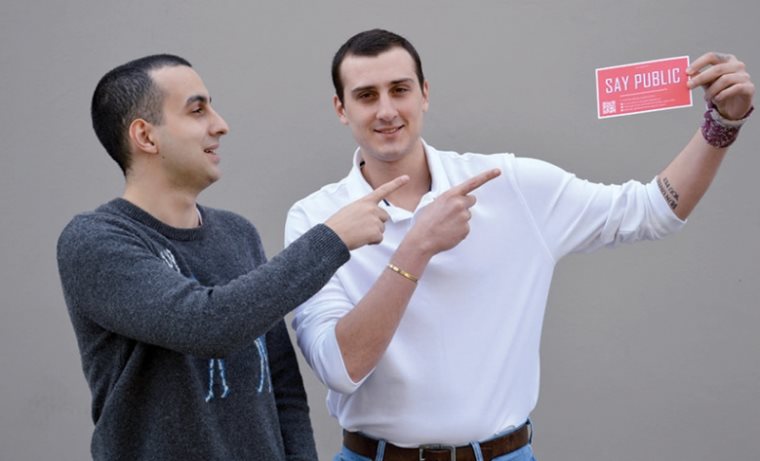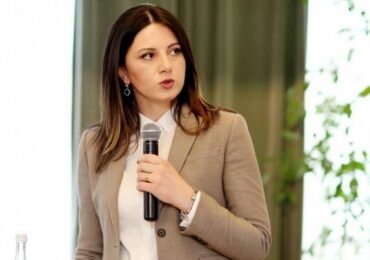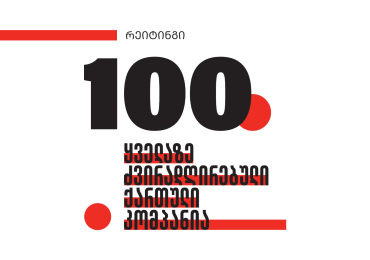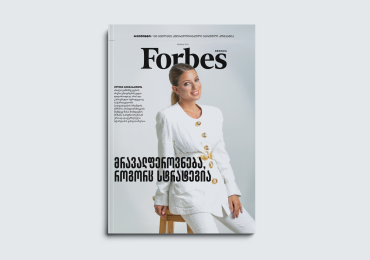Deehubs founded by Bakar Maruashvili and Giorgi Gurgenidze, is a global innovation: a social network that connects the virtual and physical worlds through billboards and projectors. The company offers tens of thousands of freely-registered users the opportunity to transform gigantic screens in different cities throughout the world, into their own personal arena, by allowing them to post on real walls, rather than virtual ones. This is about the first Georgian creators of a social network worth millions. Are you curious as to how it all happened? Well here is the story.
ACT I: A NEW HOPE
The story of Deehubs, which was named by Start Up Beat as one of the most innovative companies in the world, began on an ordinary day that childhood friends, Bakar Maruashvili, 23, and Giorgi Gurgenidze, 24, decided to turn into an extraordinary one. And that day left an indelible imprint on both of them – in both a metaphoric and literal sense. On that day, the two boys got their first tattoos. In all the excitement, they decided to try something else for the first time: attend an opera. A self-imposed novelty? Perhaps, but how else can we characterize the mood that pushed two former classmates and hard rock-loving AC/DC fans to attend a performance at the opera house? One thing is for sure, the effect of this spontaneous act can serve as a good argument in the debate on the role of contingency in success.
Can you imagine how hard it would have been for our protagonists to bear in silence the impressions of that evening? After the performance was over, they felt a longing to tell the whole world about their incredible day, which was a disruption from their everyday routines. While walking out of the opera building they saw a billboard and thought, how great it would have been to see their new tattoos posted on the billboard, instead of the boring advertisement. This was a moment when an idea to create a new social networking site was born. The new site would allow people to “post” directly on the street billboards.
“Both of us had very routine jobs. I worked for a bank, while Giorgi worked for a media agency. We were meeting every evening and thinking together about the future. We were trying to do something new,” Maruashvili said last year while visiting Forbes Georgia together with Gurgenidze. “Both of us felt that billboards on the streets were meaningless. For example, we thought it would be great if it were possible for someone to post on the big screen at Tbilisi Concert Hall and share their thoughts to total strangers in such manner,” he added.
Of course the potential of the Deehubs concept would have been less than zero if it were merely an instrument for reproducing one’s messages on the streets. After all, Graffiti is the best way to do it. But there was a serious business ambition under this seemingly altruistic undertaking: to penetrate and establish itself as an outdoor media platform, within an $8 billion market, with 14% annual growth. The scheme was actually not that complicated. Besides showing cat images, selfies and motivational quotes, electronic billboards would retain their primary advertising function, but benefit advertisers with added interactivity.
Nowadays, user participation is a strong component in advertising, which will only grow in the future. Giorgi Gurgenidze and Bakar Maruashvili decided to reflect this trend in the domain of outdoor advertising. They invented a social networking platform that would benefit users and advertisers equally: people registered and posting on Deehubs would gain in scale (and provide a platform with personal data), while advertisers would gain access to the platform with the possibility of accessing targeted audiences.
Captivated with the new concept, they began the path towards its realization, which brought them to the Startup Bootcamp Conference in Istanbul.
“We presented our concept, but more than communicating it, we were interested in networking,” noted Gurgenidze. “Neither of us were developers. We knew some basics of programming, but it was not enough. We had a lot of difficulty finding a partner in Georgia who could deal with the technical side, the kind of partner that would agree on a partnership instead of monthly remuneration,” he explained.
In Istanbul, a third voice enriched the Georgian duo. The task of translating their heart’s song into a program was taken-up by Indian developer Abhinav Saxena, who, subsequently, was a year younger than our already young protagonists.
“Saxena became very interested in our idea. We felt so much enthusiasm from him. In the first months, we were communicating through Skype, and then we registered our company in Tbilisi,” Bakar noted.
The roles in the company were redistributed as naturally as the complements were flowing between Bakar and Giorgi during the interview. Saxena worked in the technical domain writing code. Giorgi, who graduated as a film director from an academy in Paris, became the designer, and Bakar, who before returning to Tbilisi, studied finance and risk-management in the US, took responsibility for the business development side of the company.
At the beginning of 2014, a couple of months before our interview, Deehubs had already achieved considerable success. It was something to be proud of. After numerous interviews and video presentations, the demo version of the Deehubs web platform was chosen among hundreds of others, and invited to Dubai by Turn8, a startup incubator. Turn8 is a subsidiary of DP World, one of the largest port operators in the world. So in exchange for an initial investment of $30,000, which was enough to move the business offshore, the co-founders conceded a minor interest to DP World, and registered the company in the Virgin Islands together with Turn8.
“Aside from the financial support, Turn8 offered us quite a few contacts,” Bakar told me. “We get access to all the large media agencies in a city totally unknown to us. Turn8 coaches us, teaches how to lead a business meeting, and offers a lot of support in business development in general,” he says.
“When you reach them, they already know what type of support the various teams need,” Giorgi continued. “Some offered technical advice, and others, tips about business development. We, for instance, needed access to the market and potential contacts, which was precisely what we got from them.”
For a couple of months they prepared the Deehubs team for their meetings with investors. Dubai proved to be exactly the right place for a company striving to establish itself in the outdoor advertising market, since many regional head offices of large media companies were concentrated there.
ACT II: THE EMPIRE STRIKES BACK
After Turn8, Deehubs sped-up its growth, and developed a business model that is striving to implement itself to this very day. The operational mechanism of the network was planned in a way that united three platforms. The first is the user platform – a mobile app that is identical to a web application. The second platform is a program dedicated to the owners of advertisement screens, which is installed directly on the billboards themselves. The third is a brand application that allows the brand owners to see and track what kinds of interactions are taking place. Essentially the app tells them who is posting what, which allows them to deliver targeted ads.
The first two platforms were going to be connected through the web. If, for example, you register on Deehubs, you would automatically find yourself on a Twitter or Facebook-like spaces where you have friends, and have indicated your interests. However, unlike the two above-mentioned platforms, in addition, you would have the possibility to directly post your words, images and videos on a billboard, or directly send them to someone. For instance, I could tag Bakar, and whenever he passes within proximity of one of the billboards, the message: “Bakar, thank you for your collaboration with Forbes Georgia, Shota,” would appear.
This system still allowed advertisers to keep their commercials on the billboard for 24 hours, but in a different manner. The whole screen could have been filled by the status update posted by the user, but part of the screen would still display the ads. It would make it possible for an advertiser to directly interact with a consumer. For example, when my friends and I would pass in the proximity of a Coca-Cola billboard, the screen could display the following message, ‘Share Coca-Cola with Shota.’
The interactive component created the possibility for gaming as well. If I were to find myself somewhere near a Deehubs’-licensed billboard, I could receive a message that says I can play a game. The program would have found me through location services, and if I were close enough to the billboard, I could for example, play Angry Birds on a gigantic screen via my smartphone. Of course, these gaming applications would have included an ad for some kind of product. (I really can’t claim to be a master of aiming little birds towards obese piglets using a slingshot, but I surely would have astonished passersby with the grimace I wear on my face in excitement when I’m gambling. You could even sell tickets for this kind of performance.)
“If you allow a person to use a billboard as a gadget, there will be greater interaction with the screen, and greater involvement from the user’s side,” explained Bakar. “Imagine if I were to see Giorgi’s message now, or see some stranger playing a racing game, I would definitely stop to look at the screen. This is more entertaining, engaging and consequently, beneficial to the customer, as well as the advertiser.”
Indeed, testing the idea in Dubai yielded that billboards operated by Deehubs had more views than those same billboards without interaction, which was to be expected. In the past years, there were separate instances in Australia and London where billboards, as a part of a single commercial campaign, became interactive – some as a game, while others simply as a greeting message to other users. Measuring the effectiveness of screens showed that the interactive billboards produced significantly better results than static ones did.
In general, measuring the effectiveness of outdoor advertisements is harder in comparison to measuring the effectiveness of online ads. This is another advantage of Deehubs, which allows you to measure more accurately the demographics of those viewing the advertisements. Users, who sign-up for Deehubs through Facebook, automatically transmit their user and location data as well.
“Because the platform has access to your personal data, in the future, we will be able to distinguish which users, and with what interests, interact with the screens. We will also be able to gauge the effectiveness of the screen before, and its effectiveness after with Deehubs,” noted Bakar.
The Deehubs model had huge potential to change the world of outdoor advertising. The billboard owners, who purchased the Deehubs service for a fixed price, could receive access to a much larger market. Many brands that didn’t even consider outdoor advertisement as their medium of choice would now look at billboards in a new light. Passersby too would look at billboards in a different light, making commercials more effective.
“Today small apps creators like the ones who came up with Angry Birds, don’t even consider outdoor advertisements. Their focus is online. But when billboards acquire new functions, and when they become communicative so that passersby can check any app on the big screen, the brand can change its strategy,” Gurgenidze said.
A new open platform that offers developers the possibility to create apps for big screens sounds ambitious, but also stimulating. The introduction of the iPad was followed by the development of a myriad of new apps that used the advantages of a wider media very well. What would happen if electronic billboards turned to a similar, but even wider media platform? A platform in which people could build their creative products?
“We will open the platform and develop several games, which will allow average users to benefit from ads that their games receive,” said Bakar. “Brands will then have new ways to communicate. Nowadays, there is no emotional interaction between brands and passersby. This will radically change.”
However, a year ago, the market was not ready for such radical change. The roles of the main players on the digital outdoor media market were scattered, and Deehubs had to play the mediator role between different agents with discrete interests, in order to unite them around an idea; an idea that no one had realized before.
The main targets for Deehubs were not advertiser brands, but billboard providers themselves. Deehubs was offering to install their software for the screen owners for a fixed price. Following this, they would have made deals for a particular media agency, or brands themselves. In this way, screen owners were able to determine the price of the advertisements. According to Gurgenidze and Maruashvili, their system would have been attractive for brands, as Deehubs would effectively reduce their advertisement costs, since they would have been able to initiate a new campaign or be able to renew the advertisement directly from the web.
However, entering a segregated market proved to be difficult. On the one hand, there were billboard owners that were selling a display of outdoor ads on screens through a media agency, while on the other hand, there were brands that were purchasing space on screens for ads. In addition, brands needed a creative agency to approach billboard providers together. In this chain, media agencies were obviously increasing the price by adding their own margin to the price set by the screen owners.
Hence, there were four actors: the screen owner, media agency, creative agency and the brand. It proved almost impossible to mediate this revolutionary idea with all four players.
“The process has been dragged-out. It took around 5-6 months to reach the first client,” Bakar laments. “Today, for example, the app is ready, but we cannot make it available until we have the screens available.”
Last year during our interview, Deehubs hoped to strike a deal with one of the large global outdoor advertisement companies that operate throughout the world, and controls a number of billboard-owning local companies. There were few such multinationals: French JCDeux, American Clear Channel and CBS Outdoor.
If Deehubs would make a deal with the regional representatives of any of these global companies, this could have potentially opened global horizons for them. A large portion of the outdoor media market, which has an estimated worth of about $8 billion, is taken-up by the US, China and Japan. The United States alone has a market worth $3 billion, and unlike Europe or Asia, is not restricted by numerous regulations. In contrast, Dubai had many different screen owners, which required settling relations with each of them separately. The situation got complicated during negotiations with the Dubai media agencies when it turned out that those willing to be partners with Deehubs wanted to use their advertising idea only. Deehubs refused, and redirected its gaze towards the statue of liberty. “We did not want the company to turn into a single marketing solution,” Bakar wrote to me later.
If Bakar and Giorgi would have favored brands over users, and eliminated the social component from their concept, Deehubs would have been made dependent on the “ruling class” of advertisers, thereby losing the real potential of the ‘social revolution’, which can only be realized through the participation of the masses.
We know Marx’s view on this. Let’s listen to Giorgi now:
“When your startup begins working with the largest companies that are listed in Fortune 500, it’s obvious that they may try to influence several aspects of your business. They set terms and limitations. In the short-term, such collaborations can be beneficial for a startup, but never in the long-term. If we would have directly started working with the largest brands, Deehubs could have turned into a single marketing solution for an outdoor advertisement. But we had a completely different objective; we wanted to create a new outdoor media for people.”
This indecisive situation was resolved by an invitation from the startup hub Michale Luni Libes from Seattle. As such, Deehubs finally decided to move its operations to the States. Obviously, one can seek the American Dream in Dubai as well, but as the old saying goes, ‘all roads lead to Rome’.
“We left Dubai, saying goodbye to one of the advertisement agencies, and soon after, we arrived in Seattle with much optimism,” noted Bakar.
However, that optimism was short-lived.
“Unlike in the Middle East, raising funds for a startup in the United States is even harder,” Bakar said in a response to my email a few months after our initial interview. “Whereas it’s easier to standout in Dubai as a startup and generate some of the initial funds, it is much harder to achieve the same success in the United States. Many are misled thinking that going to the states will make it easy for your project to bear fruit. But if you don’t have the right contacts and background, it requires an immense amount of energy and time,” explained Bakar.
A $100, 000 investments from Michale Luni Libes and PD World in exchange for a 15% share in stocks may seem like a great deal for many. But what mattered for Gurgenidze and Maruashvili more than a controlling the share of stocks, was not to resign from their dream of establishing the company as a social media outlet. Rainy Seattle washed down their hot aspirations.
In October, the two were ready to give up. Investors from the Zino Society, as well as Alliance of Angels refused to fund the company, and were asking for stronger proof that the idea would indeed work. The lack of trust was mainly because of their small user-base, which in turn exacerbated their financial problems.
It seemed that the only possible solution was to leave the States and return to Dubai. However, this was not an option for Giorgi, Bakar and Abhinav, even if they could retain ownership of 100% of the company’s shares. No. This would mean resigning from their dream, and they were not going to let that happen. But their dream of revolutionizing social media still seemed to be failing.
“It’s hard to establish contacts. Since November we have been facing a financial shortage – even covering our livings costs has been difficult,” wrote Bakar. “Giorgi and I believe that our concept should not become another marketing company, but emerge as a full-fledged social media enterprise. No one is ready to invest in such an idea, they all direct us to advertisement agencies. Only a month is left.”
The countdown was set. Our heroes were left with two choices: either agree to the requirements of the advertisement empire, give-up the social networking component of their idea, and adapt Deehubs to the narrow marketing needs of their clients, or wait for a miracle. Unlike in Hollywood films, in real life, a dues ex machina does not appear. Bakar and Giorgi could not wait for some supernatural involvement in their plot, like something that comes to Superman’s aid when he is deprived of his powers by kryptonite, or the sword of Gryffindor for a disarmed Harry Potter.
They had to rescue the idea of Deehubs themselves, without relying much on others’ help. They had to make sure to convince investors that their concept had a huge upside.
But how?
ACT III: RETURN OF THE JEDI
When Hollywood constructs an image of a successful entrepreneur, it draws on one based on three archetypical superheroes: There is the Statistician, who locked in the wonders of his own analytical mind like a cold-blooded genius, and who may turn into a villain and easily compromise the well-being of others to realize his own mathematical calculations like Ozymandias or Jacobim Mugatu. Then there is the Cynic, who is a person obsessed not by the capacity of his own mind, but by his ego; an untrustworthy dodger who craves only success like the characters Gordon Gekko and Daniel Plainview. And finally, there is the Romantic, who is not driven by material profits at all, and is more akin to the likes of Rick Blaine or Bruce Vain.
How would each of those heroes deal with the obstacles? The Statistician would apply his mind and crude calculations. He would sacrifice each pawn without remorse in order to win. The Cynic would proceed with trickery and treachery, dooming even his own children for his personal gain. However, the Romantic, with his own heart, and despite the ambivalent nature of human beings, would rely only on his own vice. And unlike the Cynic, the Romantic would not compromise his ideals, and would not treat ‘all as the same’ like the Statistician. Instead, he would differentiate between ‘each’. He would believe that in exchange for his own good intentions, others would also embrace his noble ideas. So because of their idealism (call it naivety if you will), our Deehubs heroes more closely resemble the romantic Hollywood protagonists, which unfortunately, rarely exist in real life.
So, how did they act? They followed the common traits of the genre. Maruashvili and Gurgenidze drew upon their last resources to continue the struggle, and with this determination, they were able to inspire others and convince people who had no direct monetary interest to help realize their idea.
“We simply visited a local co-working space, gathered some people to give presentations to, and asked them to lend us projectors for a week,” recalls Maruashvili. They also asked the same via Craigslist. “We truly didn’t expect such a response! At the end of the week, we had up to 15 high quality projectors, totally free,” Maruashvili wrote.
As a result, they were able to launch a beta version of their platform, including its basic functionalities (very soon, the website will be completely redesigned). Then, the four best spots were selected in Seattle.
“We didn’t even get permission from the building owners. However, no one objected. On the contrary, they were all thrilled,” explained Maruashvili and Gurgenidze.
In the beginning, only Giorgi, Bakar and his pregnant wife were writing and posting on Twitter with the obligatory hashtags.
“As soon as someone sees that there is a message specifically dedicated to them, they definitely re-tweet it. For example, Kara Swisher and Fred Wilson responded, and a few others. However, I cannot reveal everything. Despite it all, those were hard days, Giorgi, Keti (Bakar’s wife) and me, stood alone in the rain to keep the posting updated, but everything ended well,” he said.
The ending was indeed happy. Deehubs dedication increased their recognizability, which was followed by a renewed interest from investors. It’s not a small success when a flagship magazine for tech innovations that you read regularly, dedicates an article to your project.
“Today with 10,000 displayed messages and 60,000 users, I’m so happy I rejected those corporate offers,” Maruashvili notes triumphantly in an interview with GeekWire in January of 2015. “We were members of two business incubators. When you are building a startup, you meet a lot of mentors. Everyone gives you advice and everyone tries to teach you how to do things, but often they do not have a clue about your business. If someone is successful doing other stuff, that doesn’t mean they can teach you how to build your own dreams.”
Deehubs truly found its own way of following its dream – both metaphorically and literally. The founders decided to start a dream journey in the style of 60’s road trips, driving across major U.S. cities and enabling people to display their messages. Through the two-month campaign, they hoped to gather 270, 000 more users.
Finding their own way required developing an original business model. Initially Deehubs tried to fund its own activities by licensing large providers of billboard services, like Clear Channel, JCDecaux, and CBS Outdoor. However, the company realized that by relying on large advertisers, they would have undermined the whole social media aspect of their concept. Therefore, they took another course of action. They decided to start with their own projectors, and gradually expand on billboards. Unlike license fees, which would have been divided between billboard owners and media agencies, the gains made by using their own projectors and billboards would fully be owned by Deehubs.
On the date of this publication, the fundraising campaign will have already been completed, which will deliver an additional $300,000 to the startup, bringing the business’ net worth to $3.5 million. In collaboration with their current investors, alongside Michale Luni Libes and DP world, Deehubs will dedicate the coming three years to expanding their platform. Investors are no longer skeptical: street projections turned out to be an optimal solution for Deehubs, and most of all, cost-effective and profitable. The return on investment is calculated to be merely two months. After finalizing the platform, they plan to expand from projectors to digital screens, which will make the business even more profitable. Projectors enabled Deehubs to grow rapidly, acquire legal rights, and find the right spots for the installation of digital screens going forward.
After launching the platform at full-strength, the licensing model can still be reactivated, because billboard owners will find it very hard to downplay the social aspect of the Deehubs concept.
Initial investment from Seattle angels totaling $300,000 will be enough till September. This will be followed by another Series A round of investment. The agreement has already been reached with Fenox Venture Capital. From this, and other venture capital firms, Deehubs will soon receive some $1.5 million in funds.
At this point it is hard to anticipate the exact profit margins that the future will hold. But you must take into account the current rates of growth, and that the company aims to own 55 location in three years, and 80 in five. In the case of the 55 broadcasting spots, annual revenue will reach $3.5 million, and in the case of the 80 – some $7 million. 2020 is still far ahead, but what has already become clear is that the boys were able to make their American Dream materialize, and did so without compromising their ideals. And even when the company faced an existential crisis, the founders did not give-up on their vision.
“At the end of the day, all investors and media are interested in what you can achieve when you own nothing,” says Maruashvili, now the CEO of the new Deeehubs social networking platform. “During our first meeting, the former employee of Facebook, which following the successful incorporation of Facebook became one of the largest investors in Seattle quickly dismissed me, telling me sharply to come back in a month and show them the real buzz. After a month, we came back to him with our publicity and large user-base. He was startled. After that, he began to help us with networking and setting up meetings with prospective clients.”
A major turning point in act II, and a happy ending at the end of act III, does not necessarily mean that Bakar Maruashvili and Giorgi Gurgenidze will not face any challenges going forward. In fact just recently they were entangled in an incident well known to the Georgian public. Within an advertisement campaign of Geocell, which was facilitated by Deehubs, among 8,000 posts slipped one, which rightly caused public outrage. One of the users broadcasted “Georgievsky Ribbon” with a provocative post, which indirectly justified annexation of Georgia and Ukraine by Russia.
“I am truly sorry that the one provocative post that slipped through broadcasting during the busy day (in one hour we process some 1,500 posts) damaged Geocell. Above that, Geocell was actually the only Georgian brand which from the very beginning supported our idea,” Bakar told me following this incident. “Many radical ideas are written on paper, but does that mean the inventor of paper is to be blamed or held responsible?”
Dealing with spam messages is a challenge for Deehubs in the U.S. as well. The company had to deal with a difficult PR situation when an organized attack orchestrated by 4chan was launched and resulted in many messages with racist connotations or misogynistic overtones. Abusing messages were reposted through Imgur and Reddit, thereby reaching millions of viewers.
Despite the arguable comparison with ‘paper’, one thing is for sure: Since those incidents, Deehubs has fundamentally changed the way social media posts are moderated. If earlier Deehubs was broadcasting 1,000 posts a day, today it’s about 10 times less, which means that each and every message is thoroughly inspected. Respectively, in the last month, 15,000 posts were publicized out of 28, 000 submissions. Without a doubt, the number of submitted posts will only increase. However, published posts will remain constant. Following the incident surrounding Geocell, two aspects were added to the publication process: first, was the prohibition on broadcasting any messages that directly relate to any terrorist or military operations, and second, to censor those posts which could potentially endanger a country’s security.
It is undeniable that dealing with these challenges without compromise raises the hopes for Deehub’s future. Still, we’re far from the Happy Ending. What we’re witnessing is merely a promising beginning. But the unique character of this beginning is beautifully captured in the own words of our protagonist, which I would simply requote here:
“Two years ago when we started, there was no single case of a successful Georgian technology startup. Companies in our market are mainly driven by local goals and imitation culture. It was a road full of hardships, and we did our best to reach the point we are today. It’s hard to work when no Georgian brand wants to listen to your ideas and you need to continuously argue that you are not a madman, and that your ambitions are not groundless. However, I want everyone to know, all these efforts are worth it in the pursuit of creating something that you can call your own. For Americans, it is comparatively easy. In the US, the whole system encourages youngsters and students to innovate, to come up with something new. Unfortunately, this is not the case in Georgia. I wish to see the fruits of more young Georgian entrepreneurs’ labor (thankfully, their numbers are increasing). Every revolution is different, but the one that you win against yourself is the most impressive. That is why I believe that every young Georgian that strives to create something new, and does not confine himself to the reality of Tbilisi, is already a revolutionary of this century.”
The End.

















